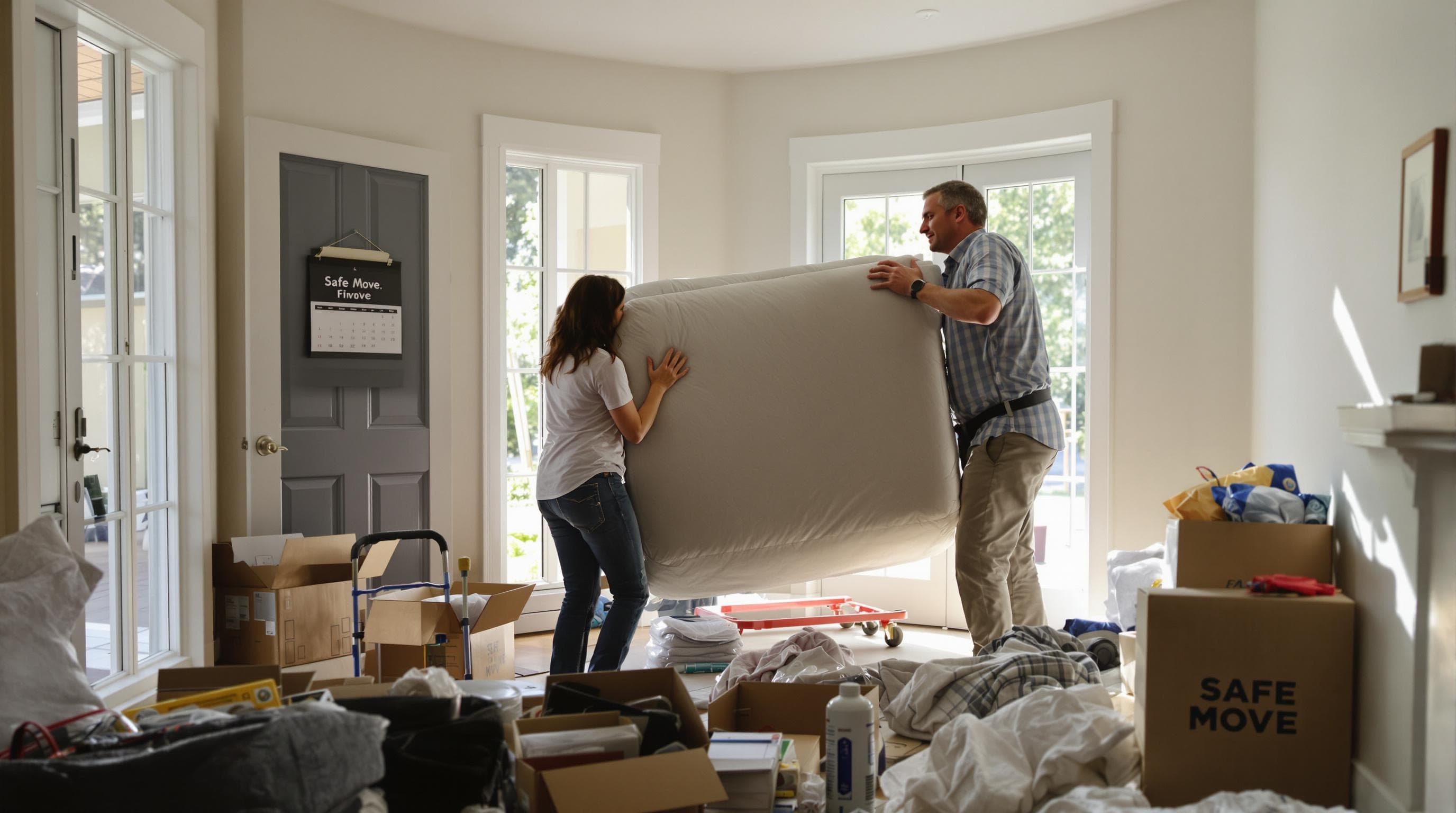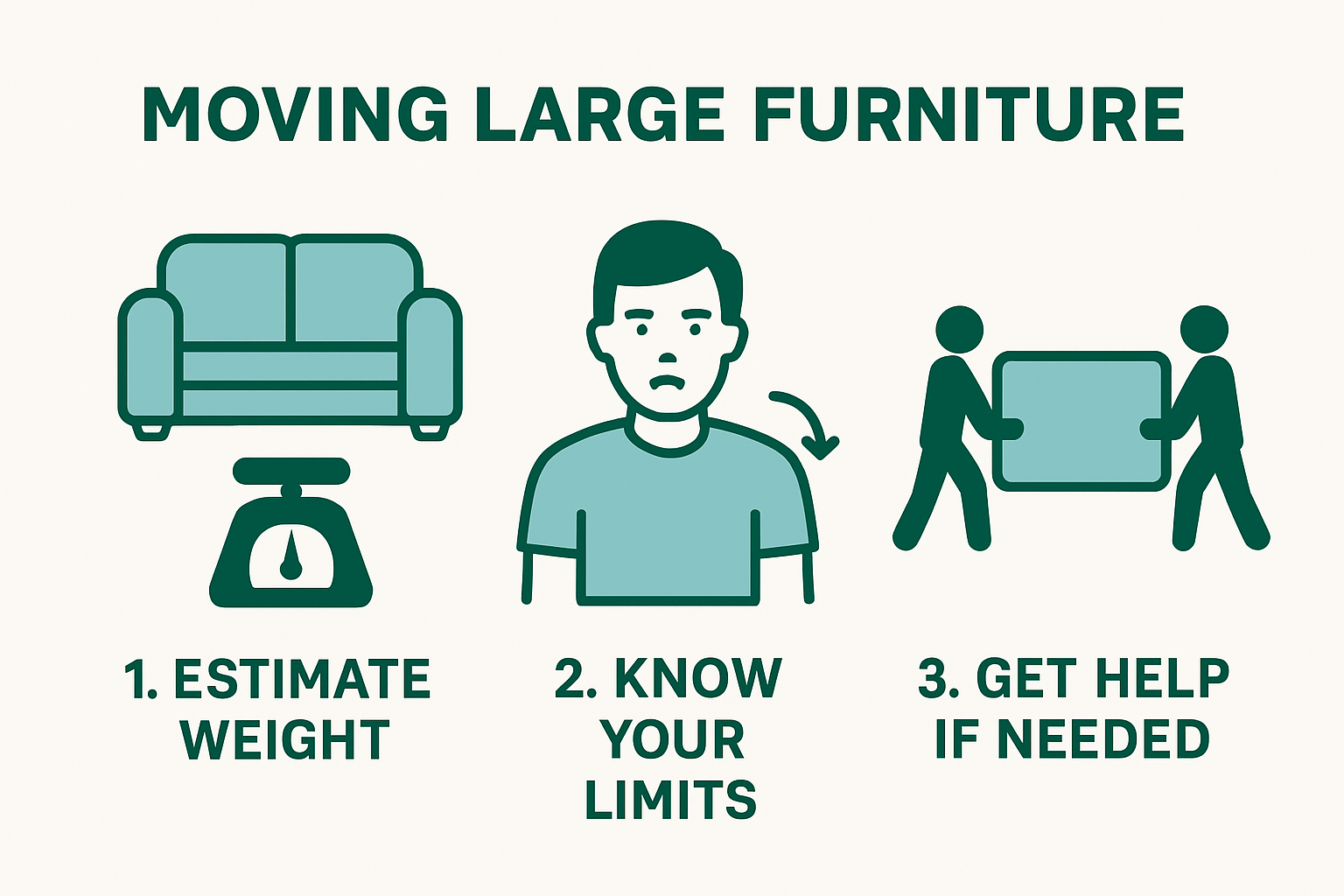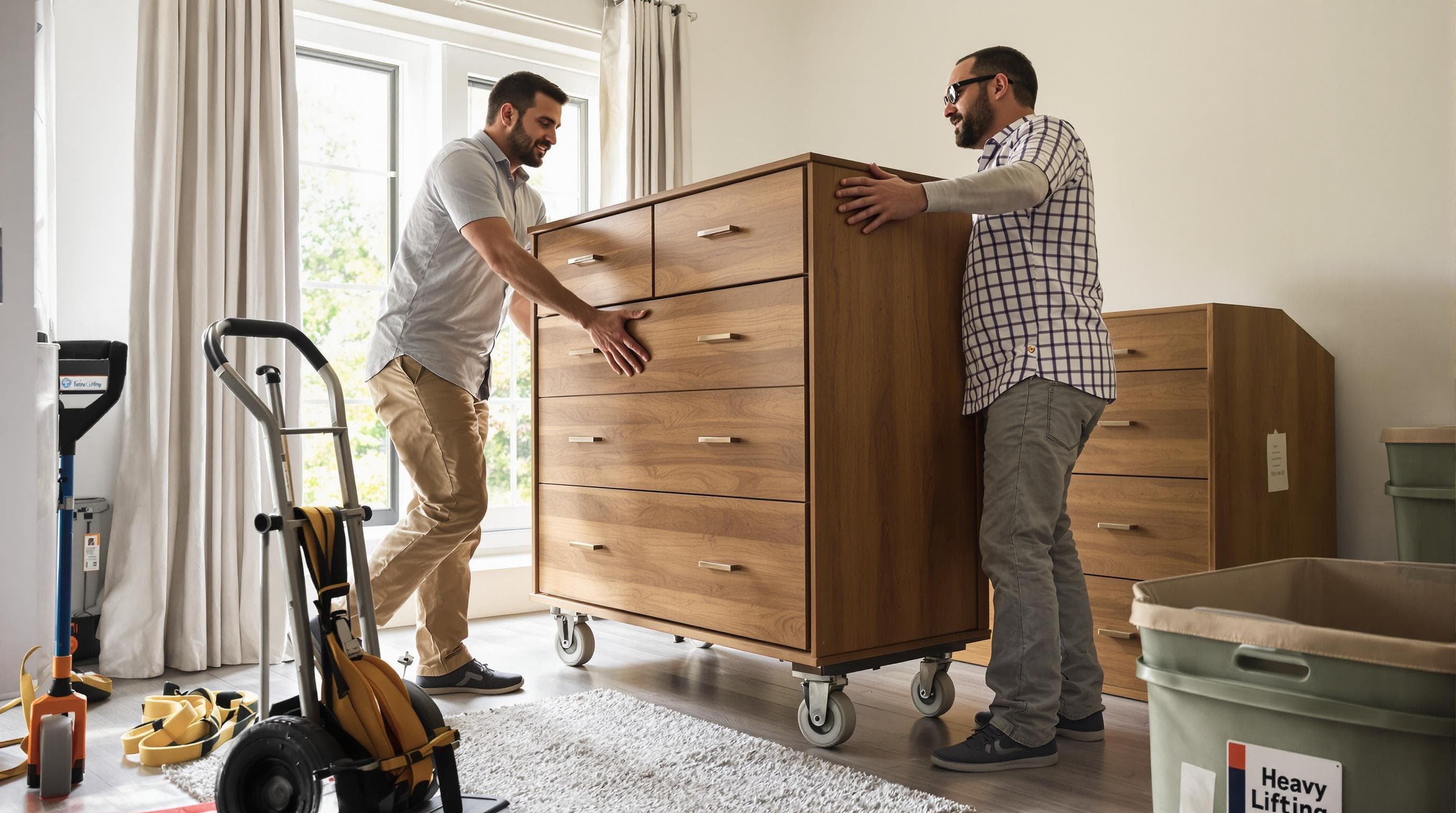
Moving a giant couch or bedroom set across South Carolina might sound straightforward. Yet studies show that lifting furniture incorrectly causes over 36 percent of all home moving injuries each year. You might think brute strength is all it takes. In reality, the smartest moves depend on careful planning, the right gear, and some tricks even pros use to keep your home and your back safe.
Table of Contents
- Planning Safe Moves For Large Furniture
- Best Tools And Techniques For Heavy Lifting
- Tips For Protecting Spaces And Valuables
- Storage And Short-Term Solutions In South Carolina
Quick Summary
| Takeaway | Explanation |
| Assess Personal Capability | Evaluate your physical strength and the complexity of the moving task. Seek help if the furniture exceeds 50 pounds or requires awkward maneuvering. |
| Use Safe Lifting Techniques | Maintain a straight spine, bend at the knees, and keep the load close to your body to prevent injuries while lifting. |
| Invest in Proper Equipment | Utilize tools like furniture dollies, lifting straps, and furniture sliders to ease the moving process and reduce physical strain. |
| Protect Your Spaces | Use floor coverings and corner guards to safeguard surfaces and prevent damage during moves. |
| Select the Right Storage Solutions | Consider portable storage options that provide flexibility and security based on your specific needs, especially in South Carolina’s unique climate. |
Planning Safe Moves for Large Furniture
Moving large furniture requires strategic planning and careful execution to prevent personal injury and property damage. Whether you’re relocating within South Carolina or preparing for a home renovation, understanding the proper techniques for moving substantial items is crucial for a safe and successful transition.
Assessing Furniture and Personal Capability
Before attempting to move large furniture, honestly evaluate your physical strength and the complexity of the task. Our guide on storage preparation offers insights into handling bulky items. According to research from Rutgers University, improper lifting techniques can lead to serious musculoskeletal injuries. Professional movers recommend performing a personal capability assessment that includes:
- Physical Condition: Evaluate your current fitness level and any existing physical limitations
- Item Weight: Accurately estimate the weight of furniture pieces
- Assistance Requirements: Determine if professional help or additional people are necessary
If a piece of furniture exceeds 50 pounds or requires awkward maneuvering, it is recommended to seek professional assistance or recruit multiple helpers.

Safe Lifting and Moving Techniques
Proper lifting mechanics are essential when moving large furniture. Purchase University’s Environmental Health and Safety guidelines emphasize the importance of maintaining correct body positioning. Key techniques include:
- Keep your spine in a neutral, straight position
- Bend at the knees, not the waist
- Use leg muscles as the primary lifting power
- Avoid twisting while carrying heavy items
- Maintain a tight grip and keep items close to your body
Additionally, wearing appropriate clothing and non-slip footwear can significantly reduce the risk of accidents during furniture moving.
Equipment and Preparation Strategies
Investing in the right moving equipment can transform a challenging move into a manageable task. Consider using furniture sliders, hand trucks, and moving straps to distribute weight and reduce physical strain. Our moving and storage insurance guide provides additional insights into protecting your belongings during transit.
Before moving day, clear pathways, measure doorways and hallways, and create a detailed plan for each piece of furniture. Disassemble larger items when possible, and protect surfaces with moving blankets or bubble wrap. By taking a methodical approach and prioritizing safety, you can successfully navigate the challenges of moving large furniture throughout South Carolina.
Remember, when in doubt, professional movers can provide the expertise and equipment needed to ensure a smooth, safe relocation experience.
Here is a table summarizing key equipment options mentioned and their primary uses for moving large furniture safely:
| Equipment | Description | Primary Benefit |
| Furniture Dollies | Wheeled platforms for rolling furniture | Reduces need for lifting heavy items |
| Lifting Straps | Straps that help distribute weight across shoulders | Minimizes strain on back and arms |
| Furniture Sliders | Slips under furniture to glide across floors | Prevents floor scratches, easy movement |
| Hand Trucks | Upright cart with wheels for heavy/bulky loads | Ideal for appliances and tall items |
Best Tools and Techniques for Heavy Lifting
Moving large furniture demands more than just muscle power. The right tools and techniques can transform a potentially dangerous task into a smooth, efficient process. Understanding how to leverage mechanical aids and ergonomic strategies is crucial for protecting both your body and your valuable belongings.
Essential Moving Equipment
Professional movers and our storage preparation guide recommend investing in specialized equipment to make heavy lifting safer and easier. According to University of California Davis Safety Services, using mechanical aids can dramatically reduce injury risks.
Key equipment for heavy furniture moving includes:
- Furniture Dollies: Wheeled platforms that allow you to roll heavy items instead of lifting
- Lifting Straps: Distribute weight across multiple muscle groups, reducing strain
- Furniture Sliders: Enable smooth movement across floors without lifting
- Hand Trucks: Vertical moving platforms ideal for appliances and heavy furniture

Advanced Lifting Techniques
Stanford University’s Environmental Health and Safety guidelines emphasize the importance of strategic lifting approaches. The key is minimizing physical stress while maximizing efficiency. Recommended techniques include:
- Maintain a wide, stable base with feet shoulder-width apart
- Keep the load close to your body’s center of gravity
- Lift with leg muscles, not your back
- Pivot with your feet instead of twisting your torso
- Plan your route and clear obstacles before lifting
Additionally, UNC Environmental Health and Safety suggests using mechanical aids like pushcarts and forklifts for particularly heavy or awkward items, which can prevent potential injuries.
To help visualize proper lifting, here’s a table outlining correct versus incorrect lifting practices as discussed in the section above:
| Lifting Practice | Correct Approach | Incorrect Approach |
| Spine Position | Neutral, straight back | Bending/twisting spine |
| Leg Usage | Lift with leg muscles | Lift with back muscles |
| Load Position | Keep close to body | Hold far from body |
| Movement | Pivot with feet, avoid twisting | Twisting torso while carrying |
| Preparation | Plan route, clear obstacles before lifting | Lifting hurriedly or without planning |
Team Lifting and Coordination Strategies
For extremely large or heavy furniture, team lifting becomes essential. Effective coordination requires clear communication and synchronized movements. Before lifting, team members should:
- Discuss the lifting plan and route
- Assign specific roles and positions
- Communicate timing and movement
- Use verbal cues like “lifting” and “moving”
- Move in unison, maintaining a steady pace
Our moving and storage insurance guide provides additional insights into protecting your items during complex moves.
Remember, no piece of furniture is worth risking personal injury. When in doubt, consult professional movers who have the expertise and equipment to handle challenging moving scenarios safely and efficiently.
Tips for Protecting Spaces and Valuables
Moving large furniture involves more than just physical transportation. Protecting your home’s surfaces, walls, and valuable items requires strategic planning and careful execution. South Carolina homeowners understand that a successful move means minimizing potential damage while ensuring the safety of both your living space and your cherished belongings.
Floor and Wall Protection Strategies
Our guide for temporary storage solutions highlights the importance of surface protection during moves. Before moving large furniture, create a comprehensive protection plan for your floors and walls. Hardwood, tile, and carpeted surfaces are particularly vulnerable to scratches, dents, and scuff marks.
Key protection methods include:
- Floor Coverings: Use heavy-duty canvas drop cloths, plastic sheeting, or specialized floor protection rolls
- Corner Guards: Apply temporary corner protectors to wall edges and doorways
- Furniture Padding: Wrap furniture legs and sharp edges with moving blankets or foam padding
- Temporary Surface Shields: Use adhesive plastic films on delicate flooring surfaces
Fragile Item and Valuable Protection
Our storage unit packing guide provides expert insights into protecting delicate items during moves. Fragile items require special attention and careful handling. Professional movers recommend a multi-layered approach to item protection:
- Use high-quality packing materials like bubble wrap, foam sheets, and sturdy boxes
- Create custom padding for unique or irregularly shaped items
- Label boxes containing fragile items clearly
- Pack breakable items separately from heavy furniture
- Use original packaging for electronics when possible
For valuable items like artwork, antiques, or family heirlooms, consider additional protection such as custom crating or professional packing services.
Furniture and Interior Damage Prevention
Preventing damage to furniture and interior spaces requires careful planning and precise execution. Measure doorways, hallways, and furniture dimensions in advance to ensure smooth passage. Disassemble larger items when possible to reduce the risk of wall or furniture damage.
Additional prevention techniques include:
- Remove doors from hinges if necessary
- Protect furniture corners with cardboard or bubble wrap
- Use furniture sliders to minimize floor scratching
- Create clear pathways before moving large items
- Avoid rushing or making sudden movements
Remember, taking time to prepare and protect your space can save significant money and stress in the long run. When in doubt, consulting professional movers who understand the unique challenges of South Carolina homes can provide peace of mind and ensure a smooth, damage-free moving experience.
Storage and Short-Term Solutions in South Carolina
Navigating storage needs during furniture moves requires strategic planning and understanding of flexible solutions tailored to South Carolina’s unique residential and commercial landscapes. Whether you’re managing a home renovation, relocating, or simply need temporary space management, the right storage approach can simplify your transition.
Portable Storage Options
Our comprehensive guide to portable storage highlights the versatility of modern storage solutions. In South Carolina, homeowners and businesses increasingly rely on mobile storage units that offer unprecedented convenience. According to the College of Charleston’s procurement guidelines, short-term storage solutions can range from three months to extended periods, depending on specific needs.
Key advantages of portable storage include:
- Flexibility: Units delivered directly to your location
- Convenience: Pack and load at your own pace
- Security: Weather-resistant containers with robust locking mechanisms
- Cost-effectiveness: Eliminating traditional moving truck rental expenses
Strategic Storage for Different Scenarios
Our mobile storage insights reveal that storage needs vary dramatically across different life situations. The South Carolina Department of Archives and Records Management demonstrates how professional storage can address multiple requirements.
Storage scenarios include:
- Home Renovation Projects
- Military Deployment Transitions
- College Student Moves
- Business Inventory Management
- Seasonal Equipment Storage
Each scenario demands a nuanced approach, considering factors like duration, item sensitivity, and accessibility requirements.
To help you evaluate which storage solution works best for the scenarios mentioned, here’s a comparative table summarizing the focus for each:
| Scenario | Key Focus | Special Consideration |
| Home Renovation Projects | Protect high-value items | Temporary, easy access |
| Military Deployment Transitions | Long-term secure storage | Extended duration, security |
| College Student Moves | Short-term flexibility | Seasonal, proximity to campus |
| Business Inventory Management | Organization, accessibility | Inventory tracking, space usage |
| Seasonal Equipment Storage | Climate protection | Humidity/temperature control |
Selecting the Right Storage Solution
Choosing an appropriate storage strategy involves evaluating several critical factors. Consider container size, climate control needs, security features, and proximity to your primary location. For South Carolina residents, protection from humidity and potential storm damage becomes particularly important.
Critical selection criteria include:
- Container size options (8ft, 12ft, 16ft, 20ft)
- Climate-controlled environments
- Secure, monitored facilities
- Transparent pricing structures
- Flexible rental terms
Remember that the ideal storage solution should adapt to your specific circumstances, providing peace of mind during transitional periods. Professional storage providers understand the unique challenges of South Carolina’s diverse environments, from coastal humidity to inland temperature variations.
Whether you’re moving large furniture, managing a home renovation, or seeking temporary space solutions, selecting the right storage approach can transform a potentially stressful experience into a smooth, manageable process.
Frequently Asked Questions
What are some safe lifting techniques for moving large furniture?
To lift large furniture safely, maintain a straight spine, bend at the knees, keep the load close to your body, and avoid twisting while carrying. Always use your leg muscles to lift, not your back.
How can I protect my floors and walls during a move?
Use heavy-duty floor coverings like canvas drop cloths or plastic sheeting, apply corner guards on walls, and wrap furniture legs with moving blankets to prevent damage during the moving process.
What equipment should I use for moving heavy furniture?
Invest in furniture dollies, lifting straps, furniture sliders, and hand trucks. These tools can help reduce physical strain and make it easier to move large items safely.
When should I consider hiring professional movers for my move?
If a piece of furniture exceeds 50 pounds, requires awkward maneuvering, or if you’re unsure about your ability to lift it safely, it’s advisable to hire professional movers or get assistance to avoid injuries.
Smooth Solutions for Every Large Furniture Move in South Carolina
Struggling with heavy lifting, tight hallways, or the stress of moving oversized furniture? You are not alone. Many South Carolina residents face the same worries, from injury risks to protecting treasured pieces and home interiors. If you want a safer, smarter answer, STOMO Mobile Storage and MOVEMO Moving Service bridges the gap between do-it-yourself tips and hands-on support right in your neighborhood.

Let us transform your move. Our family-owned service delivers weather-resistant, portable storage containers to your door and offers flat-rate, concierge-style moving. Skip hidden fees. Experience local care and real peace of mind even if you have a tight schedule or special requests. Act now by visiting our main site to explore tailored, award-winning storage and moving solutions. Your safer, easier large furniture move starts here.
Recommended
- Moving Containers | STOMO Mobile Storage | MOVEMO
- Portable Storage Charleston | STOMO Mobile Storage
- Charleston South Carolina USA: Storage & Moving Solutions 2025 – STOMO Mobile Storage and MOVEMO Moving Service
- How to Pack a Storage Unit: Expert Guide for Every Need 2025 – STOMO Mobile Storage and MOVEMO Moving Service
- How to Move Heavy Furniture: UK and International Guide 2025 | Schott Removals
